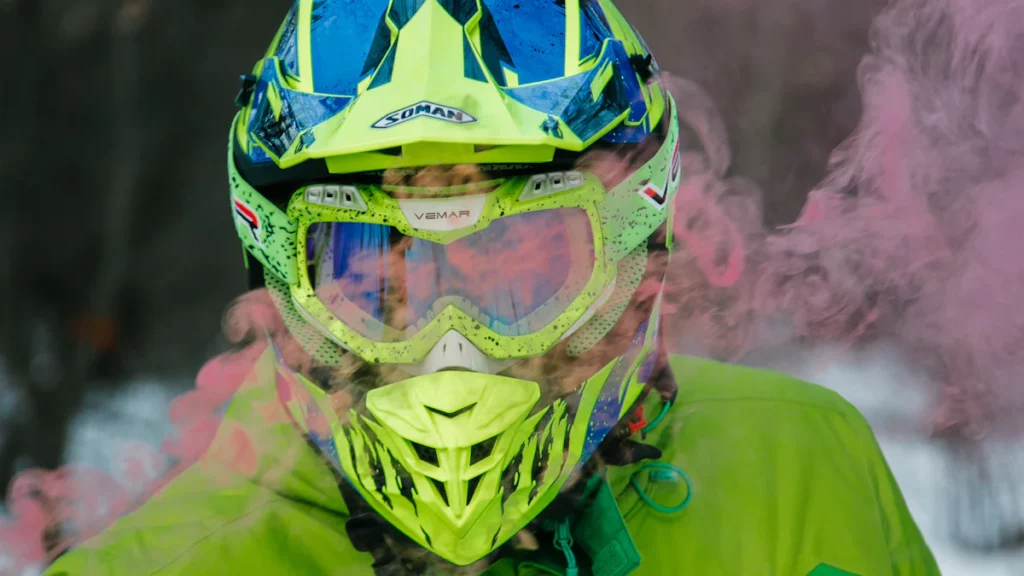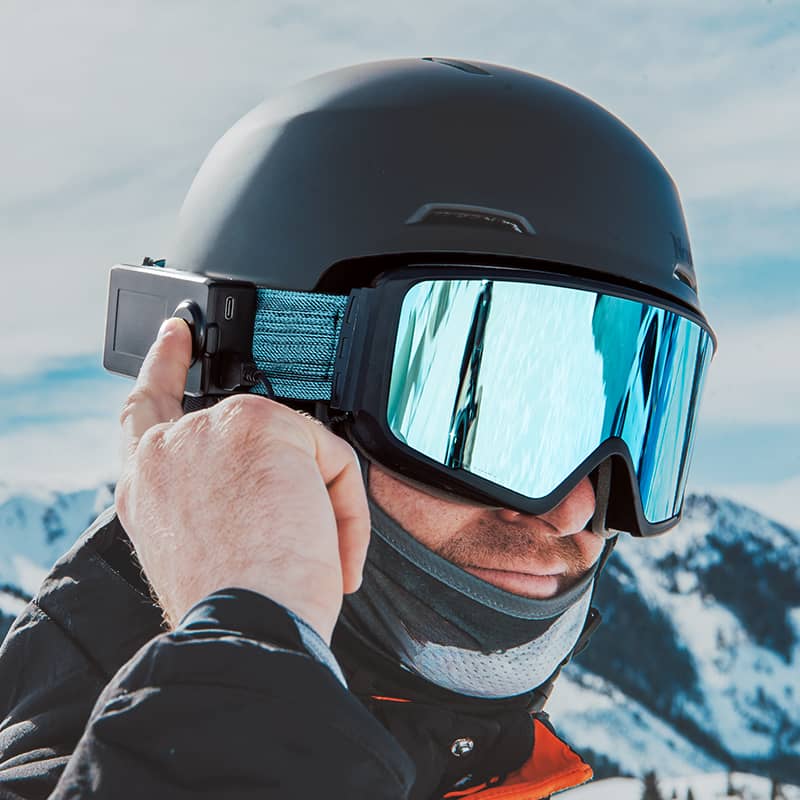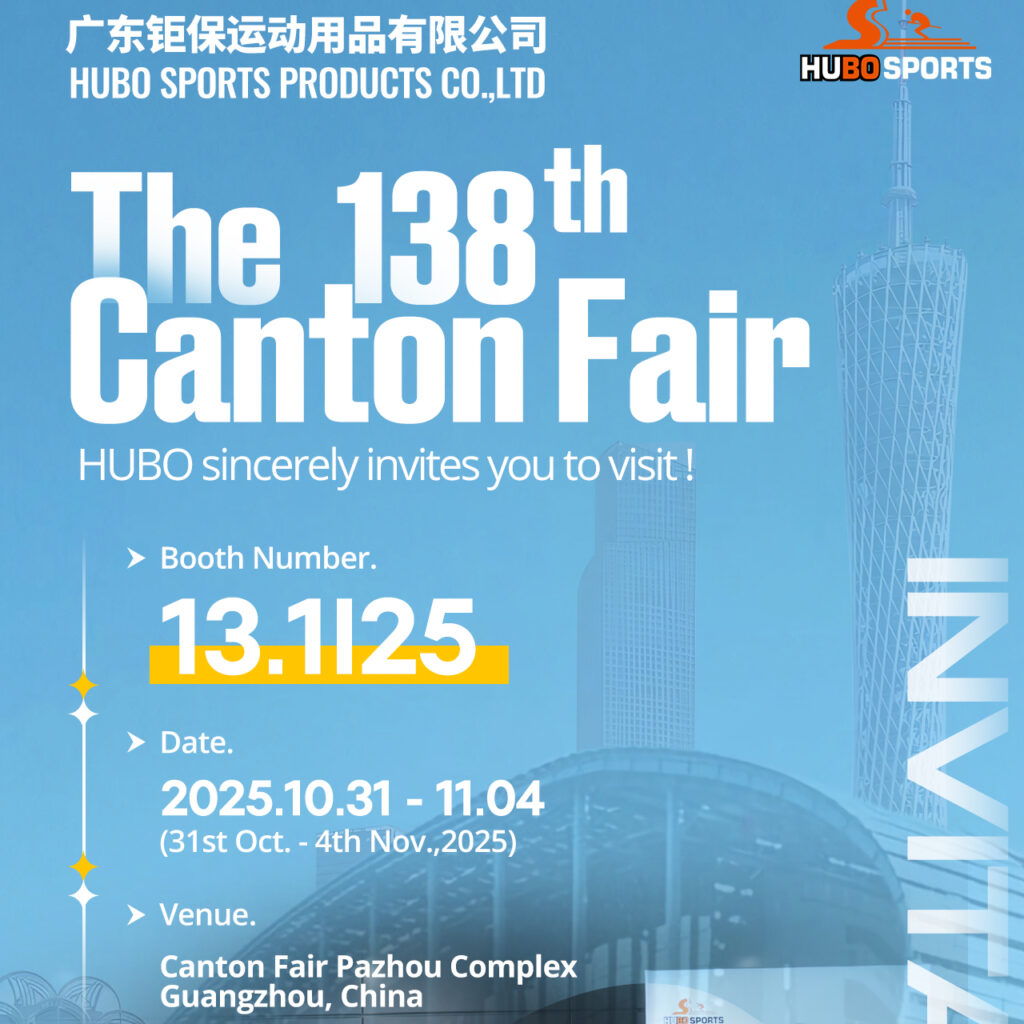स्कीइंग या स्नोबोर्डिंग के लिए ढलानों पर जाते समय, सुरक्षा और प्रदर्शन दोनों के लिए सही उपकरण होना ज़रूरी है। एक ज़रूरी उपकरण जिसे अक्सर नज़रअंदाज़ कर दिया जाता है, वह है स्की गॉगल्स। विज़िबल लाइट ट्रांसमिशन (VLT) के अर्थ और सही स्की गॉगल्स चुनने में इसके महत्व को समझना पहाड़ पर आपके समग्र अनुभव को काफ़ी बेहतर बना सकता है।
इस विस्तृत गाइड में, हम स्की गॉगल्स पर VLT के बारे में विस्तार से जानेंगे, यह पता लगाएँगे कि यह आपके लेंस के चुनाव को कैसे प्रभावित करता है, और अलग-अलग स्कीइंग परिस्थितियों के लिए सबसे उपयुक्त VLT स्की गॉगल्स के चुनाव के बारे में जानकारी प्रदान करेंगे। तो चलिए, स्की गॉगल्स पर VLT के बारे में आपको जो कुछ भी जानना ज़रूरी है, उसे विस्तार से जानते हैं!
स्की गॉगल्स पर वीएलटी क्या है?

दृश्य प्रकाश संचरण (वीएलटी) से तात्पर्य प्रकाश की उस मात्रा से है जो चश्मे के लेंस से होकर गुजरती है। मूलतः, यह आपकी आँखों तक पहुँचने वाले दृश्य प्रकाश के प्रतिशत को दर्शाता है, जो आपके आस-पास के वातावरण को कितना उज्ज्वल या अंधकारमय दिखाता है, इसे प्रभावित करता है। इसका मतलब है कि उच्च VLT प्रतिशत वाला लेंस अधिक प्रकाश को गुजरने देता है, जिससे यह कम रोशनी वाली परिस्थितियों के लिए आदर्श होता है, जबकि कम VLT प्रतिशत एक गहरे रंग के लेंस को दर्शाता है, जो अधिक रोशनी वाली परिस्थितियों के लिए उपयुक्त होता है।
स्कीयरों के लिए वीएलटी क्यों महत्वपूर्ण है
स्कीइंग या स्नोबोर्डिंग के दौरान विभिन्न प्रकाश स्थितियों पर विचार करने पर वीएलटी का महत्व स्पष्ट हो जाता है। सही वीएलटी प्रतिशत वाले उपयुक्त लेंस का चयन करने से ढलानों पर दृष्टि और समग्र सुरक्षा में सुधार होता है।
उदाहरण के लिए, तेज़ धूप वाली परिस्थितियों में, कम VLT रेटिंग सबसे प्रभावी होती है क्योंकि यह लेंस से होकर गुजरने वाले प्रकाश की मात्रा को कम कर देती है। इससे न केवल आँखों को जल्दी से समायोजित करने में मदद मिलती है, बल्कि बर्फ़ पर चमक भी कम होती है, जिससे ज़मीन की बेहतर दृश्यता मिलती है। इसके विपरीतकम रोशनी वाली स्थितियों जैसे बादल वाले दिन या सपाट रोशनी में, एक उच्च वीएलटी लेंस दृश्यता कंट्रास्ट को बढ़ाता है, जिससे लेंस टिंट द्वारा सीमित महसूस किए बिना अधिक आत्मविश्वास से स्कीइंग और सवारी करने की अनुमति मिलती है।
इसके अलावा, अलग-अलग वीएलटी रेटिंग वाले स्की गॉगल्स की कई जोड़ी दिन भर बदलती रोशनी की स्थिति के अनुसार ढलने में मददगार साबित हो सकती है। उदाहरण के लिए, तेज़ धूप के लिए कम वीएलटी रेटिंग वाली एक जोड़ी और रात में स्कीइंग या अन्य अंधेरी परिस्थितियों के लिए ज़्यादा वीएलटी रेटिंग वाली एक जोड़ी का इस्तेमाल करने से हर समय बेहतरीन दृष्टि सुनिश्चित होती है।
गॉगल लेंस VLT प्रतिशत श्रेणी
जब सही विकल्प चुनने की बात आती है स्की चश्मेढलानों पर इष्टतम दृष्टि और आँखों की सुरक्षा सुनिश्चित करने के लिए दृश्य प्रकाश संचरण (वीएलटी) प्रतिशत और उनकी श्रेणियों को समझना आवश्यक है। प्रत्येक जोड़ी चश्मे में ऐसे लेंस लगे होते हैं जिनकी एक विशिष्ट प्रकाश दृश्य सीमा होती है, आमतौर पर 0% और 100% के बीच, जो उस दृश्य प्रकाश के प्रतिशत को दर्शाता है जिसे गुजरने दिया जाता है।

S0 (80-100% VLT, कोई टिंट नहीं या बहुत हल्का)
इस श्रेणी में आने वाले चश्मे सबसे अधिक मात्रा में दृश्य प्रकाश को गुजरने देते हैं, जिससे वे आदर्श बन जाते हैं अत्यंत कम रोशनी की स्थितिये लेंस समतल या बादलों से घिरे प्रकाश में स्कीइंग के लिए लाभदायक होते हैं, जब दृश्यता काफी कम हो जाती है।
एस1 (43-801टीपी3टी वीएलटी)
इस श्रेणी के लेंस अलग-अलग प्रकाश स्थितियों के लिए बहुमुखी प्रतिभा प्रदान करते हैं। ये उपयुक्त हैं आंशिक रूप से बादल वाले दिन या ऐसी परिस्थितियाँ जहाँ मध्यम प्राकृतिक प्रकाशमध्यम रंगत, चमक से पर्याप्त सुरक्षा प्रदान करते हुए कंट्रास्ट और गहराई की धारणा को बढ़ाने में मदद करती है।
एस2 (18-431टीपी3टी वीएलटी)
इस श्रेणी में ऐसे लेंस शामिल हैं जो विभिन्न प्रकार की प्रकाश स्थितियों में रोज़मर्रा के उपयोग के लिए उपयुक्त हैं। ये मध्यम से निम्न स्तर का दृश्य प्रकाश संचरण प्रदान करते हैं, जिससे ये उपयुक्त बनते हैं। धूप वाले और बादल वाले दोनों दिन.
एस3 (8-181टीपी3टी वीएलटी)
इस श्रेणी में आने वाले लेंस वाले चश्मे विशेष रूप से डिज़ाइन किए गए हैं उज्ज्वल और धूप वाले दिनवे S0, 1, और 2 की तुलना में अधिक गहरा रंग प्रदान करते हैं, जो तीव्र सूर्य के प्रकाश और चमक के खिलाफ बेहतर सुरक्षा प्रदान करते हैं।
S4 (0-8% VLT, बहुत गहरा रंग)
इस श्रेणी के लेंस अत्यधिक उज्ज्वल परिस्थितियों जैसे उच्च ऊंचाई पर स्कीइंग या स्नोबोर्डिंग के लिए तैयार किए गए हैं। असाधारण धूप वाले दिनवे न्यूनतम दृश्य प्रकाश संचरण की अनुमति देकर सूर्य से उच्चतम स्तर की सुरक्षा प्रदान करते हैं।
VLT पर लेंस के रंग का प्रभाव
वीएलटी श्रेणियों के अतिरिक्त, लेंस का रंग यह निर्धारित करने में महत्वपूर्ण भूमिका निभाता है कि चश्मे में कितना प्रकाश प्रवेश करता है:
- गुलाब (गुलाबी लाल) और अंबर (पीला नारंगी)ये रंग समतल प्रकाश की स्थिति में कंट्रास्ट को बढ़ाकर असाधारण रूप से अच्छा प्रदर्शन करते हैं और स्कीयर को चुनौतीपूर्ण इलाकों में भी बर्फ की आकृति को पहचानने की अनुमति देते हैं।
- नीलानीले रंग के लेंस कम रोशनी वाली परिस्थितियों, जैसे कोहरे या बर्फीले मौसम में विशेष रूप से प्रभावी होते हैं। ये उच्च VLT प्रतिशत प्रदान करते हैं, जिससे प्रतिकूल मौसम की स्थिति में दृश्यता में सुधार होता है।
सही वीएलटी श्रेणी का चयन
उपयुक्त वीएलटी श्रेणी वाले स्की गॉगल्स का चयन मौजूदा मौसम की स्थिति और व्यक्तिगत प्राथमिकताओं पर निर्भर करता है। उदाहरण के लिए:
- कम रोशनी की स्थितिS0 से S2 श्रेणी के ऐसे चश्मे चुनें जिनका VLT प्रतिशत लगभग 60% से 90% तक हो। ये लेंस समतल या बादलों से ढकी रोशनी में भी बेहतर दृश्यता प्रदान करते हैं।
- खिली धूप वाले दिन: S3 या S4 श्रेणी के ऐसे चश्मे चुनें जिनका VLT प्रतिशत लगभग 5% से 20% तक हो। ये गहरे रंग के लेंस बेहतर धूप से सुरक्षा प्रदान करते हैं और तेज़ दिन के उजाले में चकाचौंध को कम करते हैं।
सभी स्थितियों के लिए कौन सा वीएलटी सर्वोत्तम है?

बहुमुखी वीएलटी रेंज वाले स्की गॉगल्स का चयन करना, जो सभी प्रकाश स्थितियों को पूरा करता है, स्कीइंग या स्नोबोर्डिंग गतिविधियों के दौरान अनुकूलनशीलता और सुविधा प्रदान कर सकता है। फोटोक्रोमिक लेंसवीएलटी प्रतिशत की एक विस्तृत श्रृंखला प्रदान करने वाले ये चश्मे पूरे दिन इस्तेमाल के लिए विशेष रूप से उपयुक्त हैं क्योंकि ये बदलती रोशनी की स्थिति के अनुसार अपने रंग को स्वचालित रूप से समायोजित कर लेते हैं। यह अनुकूली विशेषता विभिन्न मौसम परिदृश्यों में निरंतर दृश्यता और आँखों की सुरक्षा सुनिश्चित करती है, जिससे ये उन स्कीयरों के लिए एक आदर्श विकल्प बन जाते हैं जो अपने चश्मों में बहुमुखी प्रतिभा चाहते हैं।
इसके अलावा, अलग-अलग वीएलटी रेटिंग वाले स्की गॉगल्स की कई जोड़ी होने से स्कीयर दृष्टि की गुणवत्ता से समझौता किए बिना प्रकाश की विभिन्न स्थितियों के बीच सहजता से बदलाव कर सकते हैं। अलग-अलग वीएलटी प्रतिशत वाले गॉगल्स पहनकर, व्यक्ति दिन भर प्राकृतिक प्रकाश की तीव्रता के आधार पर लेंस के बीच आसानी से स्विच कर सकते हैं, जिससे बदलते मौसम के बावजूद सर्वोत्तम दृश्यता सुनिश्चित होती है।
बर्फीली परिस्थितियों के लिए कौन सा वीएलटी सर्वोत्तम है?
बर्फीले इलाकों में चलते समय, दृश्यता और कंट्रास्ट को अधिकतम करने के लिए बर्फीली परिस्थितियों के अनुरूप उपयुक्त VLT प्रतिशत वाले स्की गॉगल्स का चयन करना आवश्यक है। धुंधले या कम रोशनी वाले दिनों में, जब बादलों से घिरे आसमान या मंद रोशनी के कारण दृश्यता प्रभावित हो सकती है, उच्च VLT रेटिंग वाले गॉगल्स की सलाह दी जाती है। लगभग 60% से 90% तक के बढ़े हुए VLT प्रतिशत वाले गॉगल्स ऐसे चुनौतीपूर्ण प्रकाश परिदृश्यों में दृश्य तीक्ष्णता को बढ़ाते हैं, जिससे स्कीयर इलाके की विशेषताओं को अधिक स्पष्ट रूप से पहचान सकते हैं और बर्फीले परिदृश्यों में सुरक्षित रूप से नेविगेट कर सकते हैं।
इसके अतिरिक्त, बर्फ की स्थिति के लिए अनुकूलित स्की चश्मे का चयन करते समय लेंस सामग्री और एंटी-फॉग तकनीक पर विचार करना महत्वपूर्ण है। कोहरा-रोधी चश्मे लेंस की भीतरी सतह पर संघनन के जमाव को रोककर, ठंडे या आर्द्र वातावरण में भी प्रकाश का निरंतर संचरण सुनिश्चित करके, इष्टतम दृश्यता बनाए रखने में महत्वपूर्ण भूमिका निभाते हैं। वेंटिंग सिस्टम का एकीकरण, बर्फीले परिवेश में बेहतर दृश्य स्पष्टता के लिए निरंतर VLT स्तरों को बनाए रखते हुए, धुंध की समस्याओं के प्रबंधन में और भी योगदान देता है।
क्या 50% Vlt रात्रि स्कीइंग के लिए अच्छा है?
रात्रि स्कीइंग या अंधेरे प्रकाश की स्थिति में सवारी के लिए, 50% की दृश्य प्रकाश संचरण (VLT) रेटिंग पर्याप्त हो सकती है पर्याप्त दृश्यता प्रदान न करना इसकी अपेक्षाकृत गहरे रंगत के कारण। रात में स्कीइंग या शाम के समय साइकिल चलाने जैसी अत्यंत कम रोशनी वाली स्थितियों में, पर्याप्त चमक और कंट्रास्ट बोध सुनिश्चित करने के लिए लगभग 43% से 80% (S1) तक के VLT प्रतिशत की सिफारिश की जाती है।
- स्की पेशेवर: “फोटोक्रोमिक लेंस पूरे दिन उपयोग के लिए उपयुक्त वीएलटी प्रतिशत की एक व्यापक रेंज प्रदान करते हैं।”
- दृष्टि विशेषज्ञ: “बर्फीले इलाकों में यात्रा करते समय मंद या कम रोशनी वाले दिनों के लिए उच्च वीएलटी रेटिंग की सिफारिश की जाती है।”
निष्कर्ष
अंत में, दृश्य प्रकाश संचरण (वीएलटी) की अवधारणा को समझना और सही स्की गॉगल्स चुनने में इसका महत्व समग्र स्कीइंग या स्नोबोर्डिंग अनुभव को बेहतर बनाने के लिए अत्यंत महत्वपूर्ण है। वीएलटी प्रतिशत दृश्यता और आँखों की सुरक्षा को कैसे प्रभावित करते हैं, यह समझकर स्कीयर विशिष्ट प्रकाश स्थितियों के अनुरूप गॉगल्स चुनते समय सूचित निर्णय ले सकते हैं।


25年-香港展邀请函(横屏-英文版)-1024x358.jpg)

